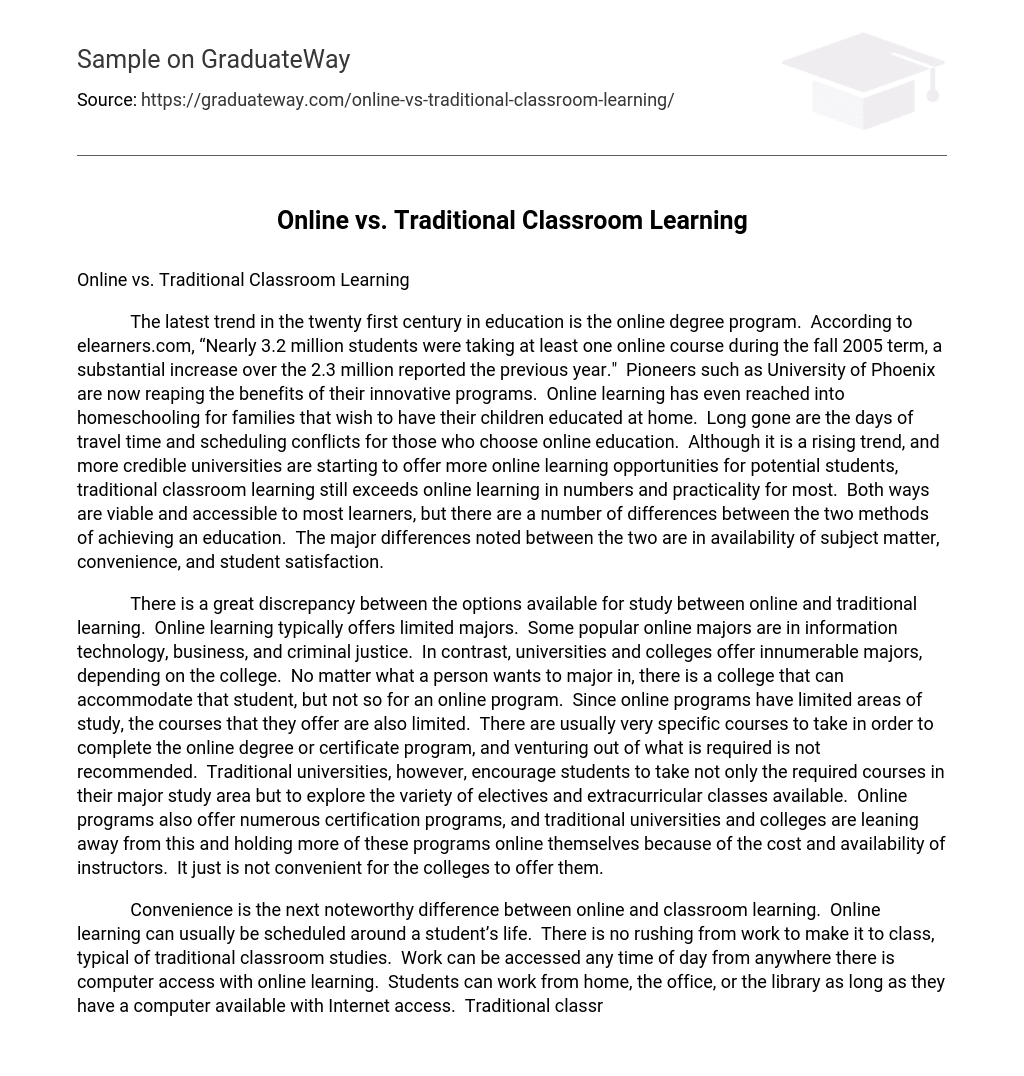The latest trend in the twenty first century in education is the online degree program. According to elearners.com, “Nearly 3.2 million students were taking at least one online course during the fall 2005 term, a substantial increase over the 2.3 million reported the previous year.” Pioneers such as University of Phoenix are now reaping the benefits of their innovative programs. Online learning has even reached into homeschooling for families that wish to have their children educated at home. Long gone are the days of travel time and scheduling conflicts for those who choose online education. Although it is a rising trend, and more credible universities are starting to offer more online learning opportunities for potential students, traditional classroom learning still exceeds online learning in numbers and practicality for most. Both ways are viable and accessible to most learners, but there are a number of differences between the two methods of achieving an education. The major differences noted between the two are in availability of subject matter, convenience, and student satisfaction.
There is a great discrepancy between the options available for study between online and traditional learning. Online learning typically offers limited majors. Some popular online majors are in information technology, business, and criminal justice. In contrast, universities and colleges offer innumerable majors, depending on the college. No matter what a person wants to major in, there is a college that can accommodate that student, but not so for an online program. Since online programs have limited areas of study, the courses that they offer are also limited. There are usually very specific courses to take in order to complete the online degree or certificate program, and venturing out of what is required is not recommended. Traditional universities, however, encourage students to take not only the required courses in their major study area but to explore the variety of electives and extracurricular classes available. Online programs also offer numerous certification programs, and traditional universities and colleges are leaning away from this and holding more of these programs online themselves because of the cost and availability of instructors. It just is not convenient for the colleges to offer them.
Convenience is the next noteworthy difference between online and classroom learning. Online learning can usually be scheduled around a student’s life. There is no rushing from work to make it to class, typical of traditional classroom studies. Work can be accessed any time of day from anywhere there is computer access with online learning. Students can work from home, the office, or the library as long as they have a computer available with Internet access. Traditional classroom students have to physically be in the classroom. This means transporting themselves to the school and showing up for a lecture under the discretion of the instructor. Homework is usually scheduled and due on a pretty strict schedule, and students are expected to be in class when class is held. Online classes usually have support and discussion boards for the students who need extra help with their studies. This can also be accessed at any time. Traditional classroom students may or may not have discussion boards to work with, but they must rely on the availability of their instructors or help centers at school if they need additional assistance with their studies. Online learning is very convenient; it works around the student, whereas traditional classroom learning forces the student to work around it.
Student satisfaction of online learning can vary immensely from the traditional classroom education. While there are numerous resources for online learners such as online support and discussion groups, as previously mentioned, there is no one on one interaction with an instructor face to face. Face to face interaction with a human instructor is often more rewarding in the sense that the student has the assurance that the instructor understands his or her needs. Face to face contact allows for nonverbal communication to complete the message; something altogether lacking from online learning. Online learners also do not have the chance to interact with their instructors on a personal level. Classroom learners often become close with their instructors because they see them as human and approachable, not text on a screen or messages in an email. However, online learners still have the benefit of controlling their education a bit more than classroom learners, who are confined to the mood and rules of someone else’s environment during their learning process. Online learners are often very comfortable doing their work in their home and do not miss the human interaction that classroom instruction provides.
Online learning has expanded higher educational opportunities for thousands. It has allowed people who normally would not be able to attend college or who were leery of doing so to take control of their own education and pave a road of opportunities for themselves. Online learning and classroom are very different when it comes to majors available, classes, electives, and extracurricular activities. They also differ in convenience and student satisfaction. It depends on the student which environment will work better.





